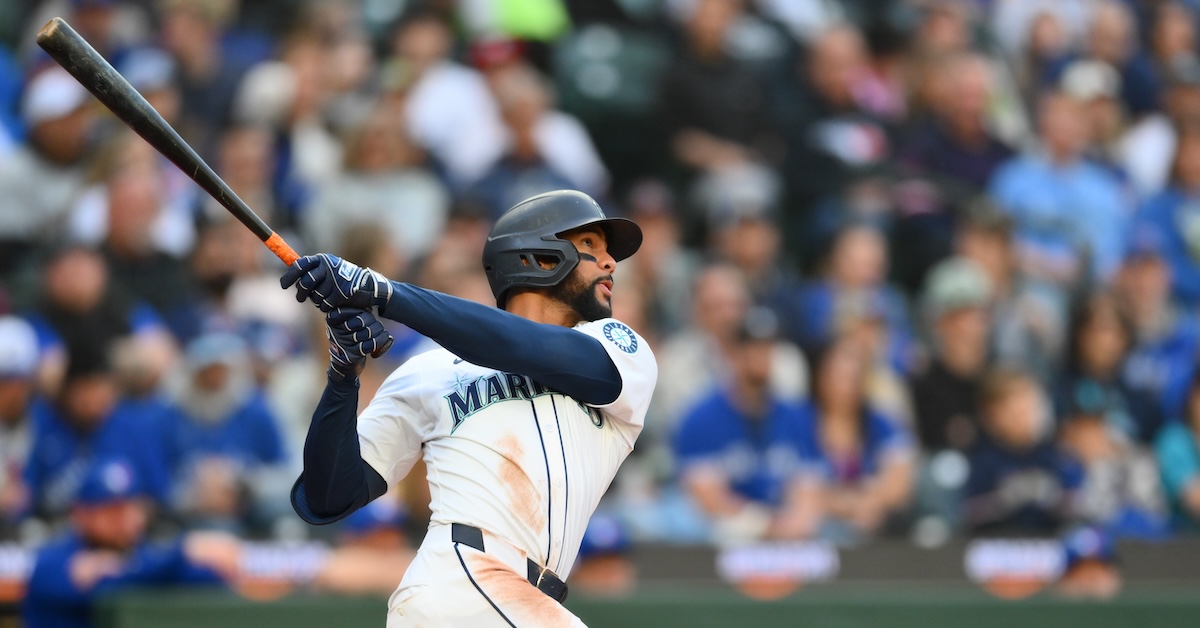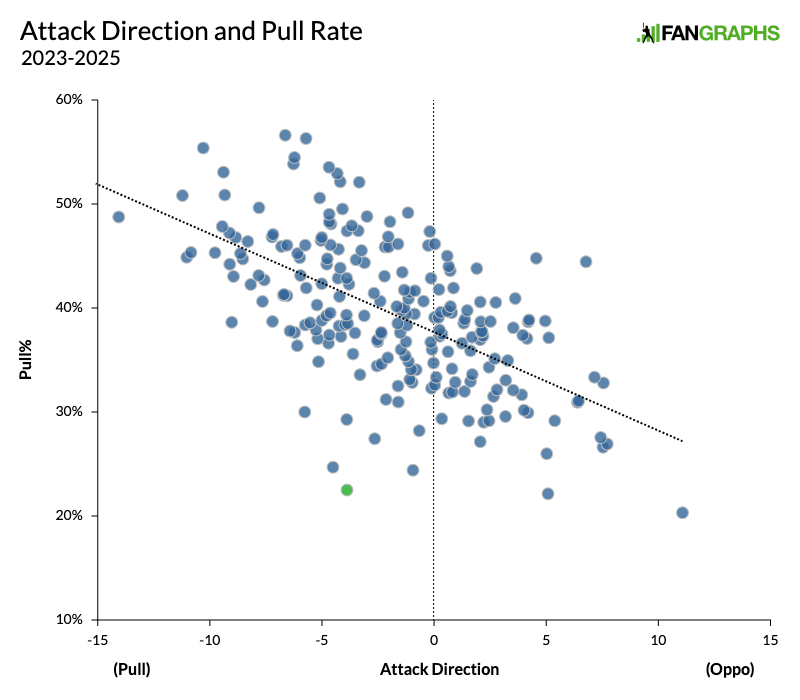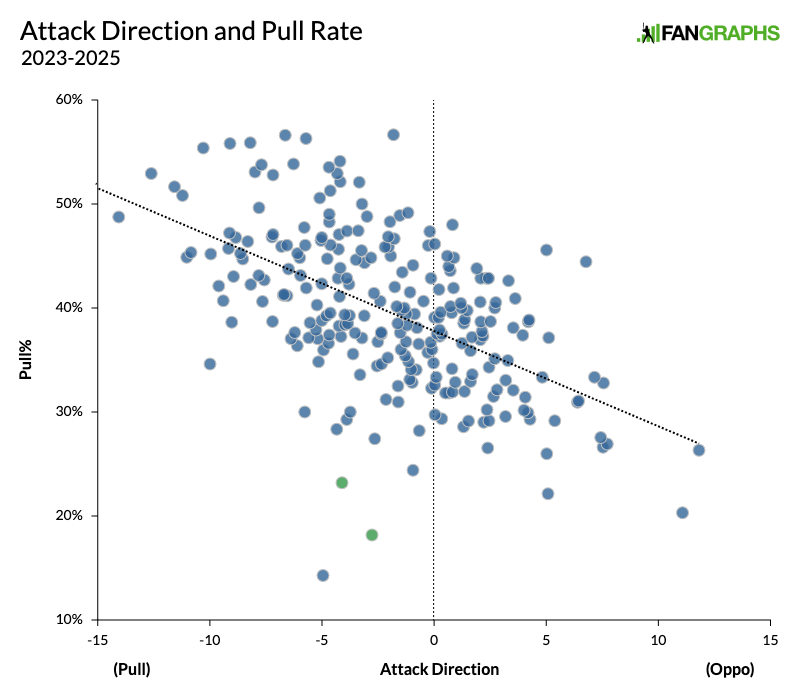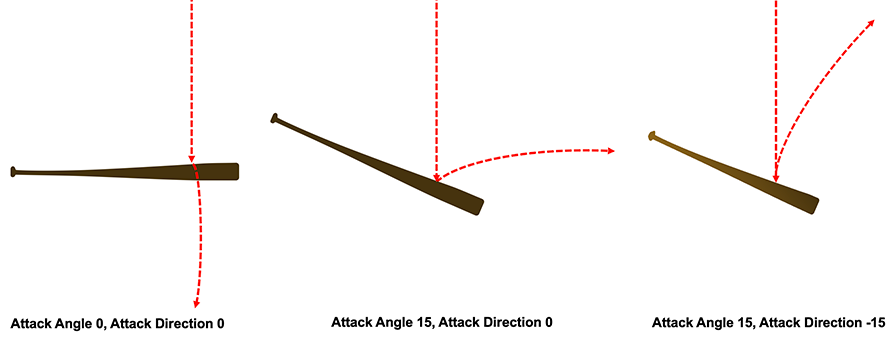How To Pull the Ball to the Opposite Field

Yesterday, I wrote an introduction to Statcast’s latest round of bat tracking metrics. MLB.com’s Mike Petriello wrote a real primer, so I tried to build on that by analyzing how the different metrics work together using a couple common pitch types. We’re still figuring out how to use these new toys, but today I’d like to explain how my first dive into the bat tracking metrics led me to one particular player who is doing something weird, which led me to learn something small about the way swings work. After all, that’s why we’re here exploring all these strange new numbers in the first place.
In my first shot at playing with the metrics, I tried to establish something simple. I pulled the overall bat tracking data for all qualified players, and I focused on Attack Direction, which tells you the horizontal angle of the bat at the moment of contact (or, in the case of a whiff, at the moment when the bat is closest to the ball). That seemed pretty straightforward to me. As with most bat tracking metrics, it’s also a timing and location metric. You generally need to meet inside pitches further out in front of home plate. If you’re behind the pitch, your bat will be angled toward the opposite field, and you won’t pull the ball. If you’re out in front of the pitch, your bat will be angled toward the pull side, and you’ll pull it. A player’s average Attack Direction should correlate pretty well with their pull rate, and the numbers pretty much bear that out. Attack Direction and pull rate have a .60 correlation coefficient:

Most of the dots are clustered around that very clear trendline. Players who pull the ball more tend to have their bats angled toward the pull side just as you’d expect. What interested me was that green dot way at the bottom. It belongs to Leody Taveras. I guess it is Leody Taveras, if we really believe in our graphs, which we probably should at this particular website.
Taveras has a moderately low Attack Direction, four degrees to the pull side, but he’s got the third-lowest pull rate of any player on this chart. I couldn’t help wondering how exactly he was doing that. Before I dug into it too deeply, I was reminded that the fact that he’s a switch-hitter might have something to do with it. So I pulled the data again, this time separating out all players by handedness. On the chart below, switch-hitters will appear twice:

The correlation isn’t quite as strong, because switch-hitters are now broken into two different players with two smaller samples (that’s how small-sample right-handed Patrick Bailey got way down at the bottom). But there are two green dots now! And they’re both Leody Taveras! From both sides of the plate, Taveras looks like he should have a pull rate that’s a bit above average, and instead has one of the very lowest pull rates in the game. At this point, I was officially curious, so I started poking around.
First, I specifically looked at Attack Direction on balls hit to the opposite field. Since the start of bat tracking midway through the 2023 season, when Taveras hits the ball the other way, his average Attack Direction is three degrees toward the opposite field. Only four players in baseball have an average Attack Direction that’s less oriented toward the opposite field. Oddly, they’re all sluggers. Salvador Perez, Yordan Alvarez, Aaron Judge, and José Ramírez are all at two degrees toward the opposite field, and Austin Riley is tied with Taveras at three degrees. Taveras is definitely not a slugger. He could not be more different from these five guys. So not only is he doing something way different from most hitters when he goes the opposite way, but the only players out on that ledge with him have completely different swings than he does. There really is something weird about him.
Next, I tried looking specifically for balls hit to the opposite field even though the bat was angled toward the pull side at the moment. Just 21% of balls hit to the opposite field have the bat angled toward the pull side at all. I ran a Baseball Savant search, setting the minimum Attack Direction at seven degrees toward the pull side. Since bat tracking started, 5.5% of Taveras’s batted balls have fallen into this category. Among the 375 players with at least 200 BIP over that period, that’s the 11th-highest rate. Elehuris Montero is the champion at a shocking 10.5%, but no player who has put as many balls in play as Taveras has run as high a rate as he has.
At that point, I decided to look at individual balls that fell into this category: balls that go to the opposite field even though the bat is angled toward the pull side at contact. How exactly does this happen? Try to picture it in your mind. If the bat is angled toward the pull side, and it’s being swung in that direction anyway, how does the ball end up going in the opposite direction? There are two main answers. Here’s the less common way:
That’s Taveras way, way out in front of a curveball, hitting it off the very end of his bat. He cued it up so perfectly that if the end of his bat were cupped, the ball might have just gotten stuck in there. So that’s one way to do it. In fact, 21% of the balls we’re looking at, hit to the opposite field even though the Attack Direction is seven or more degrees to the pull side, are squibbers hit off the end of the bat below 80 mph. That’s one way to do it.
The other way is much more common, and it looks like this:
Of those same balls, hit to the opposite field even though the Attack Direction is seven or more degrees to the pull side, 50% are classified as popups, and 65% have a launch angle above 38 degrees. Basically, when you hit a ball in that weird manner, it’s almost always going to be either a cue shot or a popup. Leody Taveras taught me that.
This has a lot to do with Attack Angle. If your bat were perfectly parallel to the ground, but angled toward the pull side, it would be pretty much impossible to hit the ball the other way. But when you pop the ball up, you’re not hitting it flush. You’re getting under it. And regardless of the situation, your bat is almost never parallel to the ground. According to Statcast, the bat is angled downward on more than 80% of swings. If you just look at popups, that number is up above 90%. About half of popups come on four-seamers and cutters, where the batter has trouble catching up and swings just under the pitch. The rest come on softer stuff, and those pitches are usually low in the zone. I need you to do some 3D visualization in your head here, because my diagram is not very good:

On the left is a perfectly level bat, parallel with the front of the plate. Now imagine you’re angling your bat downward and you get just underneath the ball. If your bat is angled toward the opposite field or, as in the middle example, straight toward center field, you’ll likely just foul the ball off behind you or into the opposite field stands. Once you angle it toward the pull side, however, it can stay fair, bouncing up and toward the opposite field. Please imagine that the bat on the right looks so funky because it’s foreshortened, pointed out toward the first baseman. Taveras can show us what that looks like in the real world:
If his Attack Direction were zero, he would’ve fouled the ball up and into the stands down the third base line. He only kept it fair because of his Attack Direction of 18 degrees.
Look, I don’t have a big takeaway here. I just think this interesting. I think it highlights the way that the angle of the bat informs even the most mundane batted balls. If you’d asked me yesterday whether it’s possible to go the opposite way while your bat was angled toward the pull side, I would’ve had to think about it, but my first reaction would’ve been to say no. The bat and ball move through space so quickly that they can be hard to track, but the bat tracking metrics help explain why exactly Taveras pops out so very, very often, and how it’s even possible to hit a ball like that in the first place.
Davy Andrews is a Brooklyn-based musician and a writer at FanGraphs. He can be found on Bluesky @davyandrewsdavy.bsky.social.
This is not unusual for hitters, just for big leaguers (because they’re *good*).
This is what happens to guys whose bats get out of the hitting zone too quickly (don’t “stay through”): they pop a lot of stuff up backside (or foul it off)
He’s an outlier because most guys who get to the big leagues have done more to fix this issue on the way up